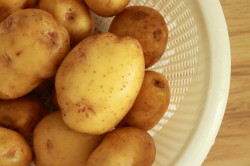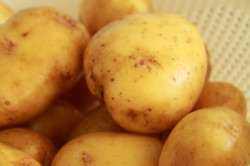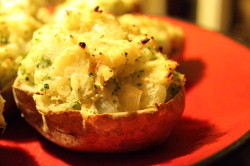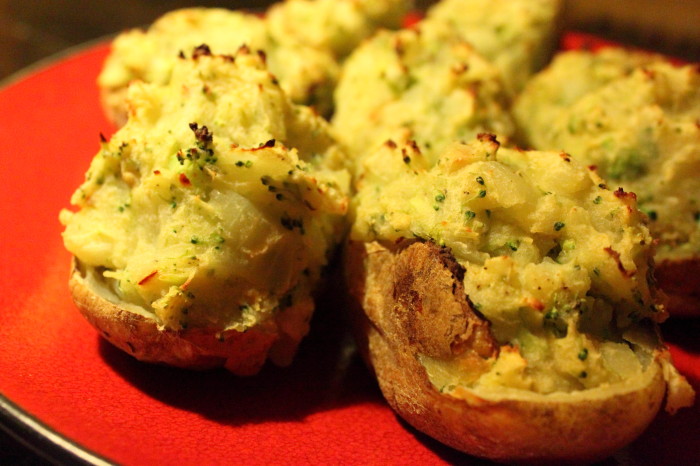
Home-grown Yukon Gold potatoes. With an appealing golden hue and creamy flesh, it’s no wonder that subjects of an experimental all-potato diet “did not tire” of them and had “no craving for change.”
Mashed, scalloped, or au gratin, potatoes are likely to make an appearance on your family’s holiday table. As yummy and prevalent as they are, you might have heard advice against eating potatoes, especially white potatoes. I always hear that you should eat plenty of fruits and vegetables, except white potatoes. In fact, potatoes are chock full of vitamins, minerals, and contain fiber and protein. Potatoes have almost twice as much potassium as bananas, and almost as much vitamin C as oranges. There have been multiple experiments in history where people subsist entirely on potatoes and thrive (even athletes)! Why do we hear advice to avoid them? Because of how they are usually cooked (i.e. in oil like french fries) and because of a misunderstanding about carbohydrates.
All too often I see warnings in fitness and health magazines to “watch out for carbs this holiday,” and terrifying exclamations of “carbs are the enemy!” There is no doubt about it: potatoes are full of carbohydrates. But are they really the enemy of a fit and healthy body? The carbohydrates in potatoes take the form of starch, a complex carbohydrate chain made up of glucose molecules. Simply put, the word “glucose” causes a red flag to be thrown up about potatoes because of the word’s association with diabetes.
Throughout mankind’s existence we have stored away the energy in our food as fat on our bodies. During times of food scarcity our bodies would draw upon these fatty energy stores to survive until the time of plenty returned. In modern America, it’s not the scarcity of food that is the problem–rather, the overabundance of calories. But our bodies continue to store the fat in our food as fat on our bellies, butts, and thighs, since this strategy has served our bodies well in the past. The result of this overabundance of fat and calories is weight gain. Since we continue to feed our bodies fatty, high-calorie foods, the body has no choice but to begin to resist taking the nutrients in. Our bodies develop a resistance to insulin, the hormonal gatekeeper of our cells, which is the body’s way of striving for balance. This causes the nutrients we eat–including the glucose in starch–to remain floating in our blood. High blood sugar, insulin resistance, and type II diabetes are the result. (See this excellent, if lengthy lecture by Dr. John McDougall on diabetes and a plant-based diet).

Diets high in fat, not starchy foods like potatoes, lead to high blood sugar, insulin resistance, and type II diabetes.
Critics of everyone’s favorite tuber will say that eating potatoes makes blood sugar rise, so they should be avoided. I say to them that blood sugar is supposed to rise when we eat! The body prefers to use carbohydrate as a source of energy. The sugars in our blood after eating a whole plant-based meal fuel our brains so we can think clearly and feel vibrant. Although nutrition science supports this claim, we need look no further than our senses to confirm it. Compare the feeling you have after eating a plate of oil-free vegan shepherd’s pie or broccoli-stuffed twice-baked potatoes (recipe below!) to the sluggishness that comes after eating a low-carbohydrate meal like egg and heavy cream quiche topped with cheese.
Aside from great nutrients, potatoes are your friend this holiday season because they fill you up and keep you full if you do decide to indulge in a holiday cookie or treat. I love potatoes boiled and then mashed with peas and carrots stirred in. I recommend adding a little low-sodium soy sauce and nutritional yeast for added flavor. Or put a bit of curry powder in the mix, fold into whole wheat lavash or flatbread, then bake for home made potato samosas.
So don’t be afraid of these guys and make them a part of your holiday cooking! Try my delicious, oil-free Broccoli Stuffed Twice Baked Potatoes on the next page.
Once, I saw on Facebook that a friend made mashed potatoes that she described as “so simple, just cream cheese and butter!” My version is even more simple, just whole boiled potatoes mashed with a little water. Fattening dairy products are easy to avoid for experienced vegans. All too often though, the go-to substitute for dairy in a vegan recipe is oil. Did you know that all oil is 40 calories per teaspoon? Olive, corn, canola, coconut, and vegetable oils are all made up of only one macronutrient: fat. When we cook two diced potatoes (around 300 calories) in just one tablespoon of olive oil (120 calories) our vegan meal ends up being 40% fat. As a former oil-user I know that one tablespoon is a highly conservative amount of oil in cooking. In reality the dish might better be described as “olive oil with a side of potatoes!” To keep the calories down and keep your potato dish healthy, try leaving out the oil.
For a traditional American fare potato dish that looks great on the plate and tastes even better, try this recipe:
Broccoli Stuffed Twice Baked Potatoes
(from www.wholefoodvegan.com)
Ingredients:
5 lb Bag of organic russet potatoes, rinsed
3 Heads broccoli, roughly chopped
1 Onion, chopped
4 Cloves garlic, sliced
1/2 Cup nutritional yeast
1 Teaspoon crushed red pepper
2 Tablespoons reduced-sodium soy sauce (if desired)
Preheat the oven to 450F. While the oven heats, add the chopped broccoli to the bowl of a food processor and process a few times until the florets are very small. Transfer the broccoli to a large bowl and set aside. Bake the potatoes on a baking sheet covered in foil for 90 minutes.
Meanwhile, saute the garlic and onions in a pan over medium high heat. Use a tablespoon or two of water to prevent sticking. As the water evaporates, add a little more (this is called the water saute method, and it keeps this dish fat-free and whole because no oil is needed). Transfer the garlic and onions to the bowl with the broccoli.
When the potatoes are done, remove from oven and carefully slice in half. Use a potholder to hold each potato half and scoop the inner flesh into the large bowl with a spoon. Leave enough potato in the skin to retain the canoe shape. When all potatoes are scooped, add the nutritional yeast, crushed red pepper, soy sauce, and 1/2 cup of water. Use a potato masher to mash all of the ingredients together.
Use a large spoon to fill the potato boats with the broccoli & potato mixture. You can mound the stuffed potatoes high as long as the filling lasts. Bake the stuffed potatoes for 10 minutes until just browned. Enjoy!
Also by Chelsea: 5 Stunningly Simple and Beautiful Recipes
Oil-free Vegan Whole Wheat Bread
__
Photo: Chelsea Ihnacik


